Flat Fantastic and Fun – Fissidens
Fissidens is flat. Very flat. Nearly all mosses have their leaves spirally arranged around the stems and branches. While some of them may have a superficially flattened aspect termed “complanate,” looking as though they were pressed by a miniature iron or trampled by microscopic hikers, only a few mosses are truly two-dimensional, with leaves running in paired straight strictly opposite rows.
Fissidens is fairly well represented in Ohio, with 14 species recorded. The one most frequently encountered, known from 70 of our 88 counties, is Fissidens taxifolius, which will serve as an introduction to the genus. (Note: distribution data presented here are from the draft records currently in spreadsheet form compiled by OMLA members Barb Andreas and Diane Lucas, that will soon be used to update the moss atlas on our website.) This is a mid-sized species, 4-8 mm high, with leaves 1.5-2.2 mm long. Occurring on damp shaded soil and rock, often in calcareous places, you are likely to see it on the margins of woodland trails. The photo below was taken in a woodlot on the OSU campus in Columbus. (Note: most descriptive and ecological information presented here is from Crum and Andersons’s 1981 manual Mosses of Eastern North America published by Columbia University Press.)
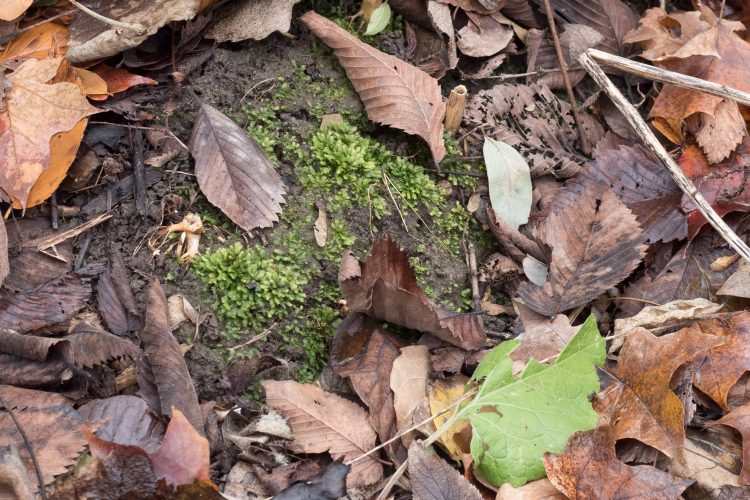
F. taxifolius is frequent on bare soil along woodland paths.
The sexuality of F. taxifolius is autoecious, i.e., monoecious with archegonia and antheridia in separate inflorescences on the same plant. Like many other co-sexual mosses it frequently produces sporophytes. They arise from the base of the gametophyte stem, i.e. are “lateral,” and this position is a useful characteristic to note because some other Fissidens species produce their sporophytes terminally. The seta is about 1 cm tall, topped by slightly inclined cylindric capsules overtopped by a cucullate (hooded) calyptra (cap) initially covering a prominently beaked operculum (lid). The peristome teeth (not shown) are each split into two branches, the basis for the genus name from the Latin fissus, cleft, and dens, tooth. Accordingly, one common name is “fork moss.”
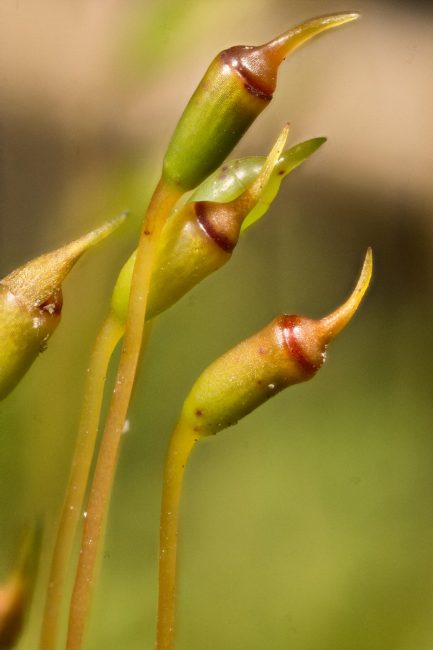
Sporophytes of Fissidens taxifolius
Fissidens, our only commonly enountered truly flat genus, and has another peculiarity as well, not seen in any others. Each leaf is split at the base, forming a neat little pocket into which is fitted the base of the next leaf up (hence the other common name “pocket moss”). Suggestive of how an equestrian’s legs clasp a horse, this is called an “equitant” arrangement. Iris leaves are similarly arranged.
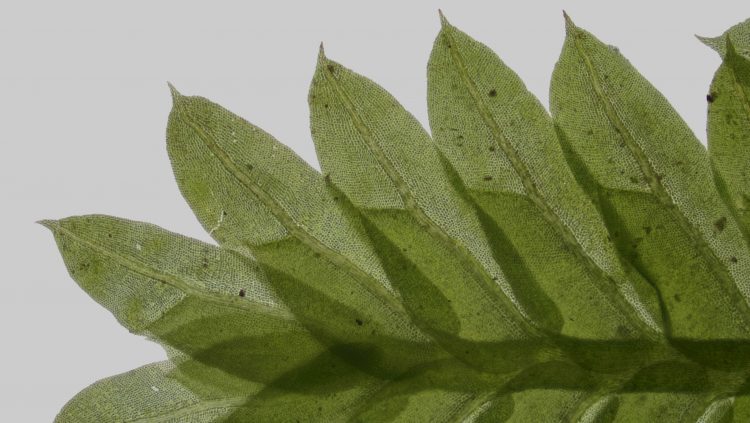
Fissidens taxifolius through the microscope

Fissidens taxifolius in the field
Our species range in size from the insanely tiny Fissidens closteri (featured elsewhere in this issue) just a few millimeters long found on wet rocks in or near streams, to densely tufted plants of F. adianthoides, up to 2 centimeters tall, found on the ground in alkaline prairie-like glades and the even longer strands of the aquatic F. fontanus attached to rocks in flowing streams.
While some pocket mosses can be field-recognized with some certainty based on size and substrate, definitive identification often draws on microscopic leaf traits, particularly cell size and shape, presence or absence of a pale margin, leaf-tip serration, and whether the leaf is extended past the costa (mid-nerve) into a claw-like tip. Here I describe Ohio’s species, in order from smallest to largest based on the maximum leaf lengths cited in Crum and Anderson.
Fissidens elegans (F. ravenelii of older works, including Crum and Anderson) is a southern species that just barely makes its way up to Ohio. (Beware that if, like me, you’ve started using Bruce Allen’s Mosses of Maine as your principal reference work for local material, this is one of the few Ohio mosses not covered therein.) You’ll find it most often on damp bare sandstone cliffs (where it might be mistaken for F. bryoides or F. minutulus), although it may also occur on the ground (where confusion with F. bushii is possible). Its outstanding trait is a microscopic one—the leaf cells are strongly pluripapillose. Also, the leaves are bordered by linear cells along the vaginant laminae (the clasping portion of the leaf). Fissidens elegans is known from 10 Ohio counties, all within the Allegheny Plateau.
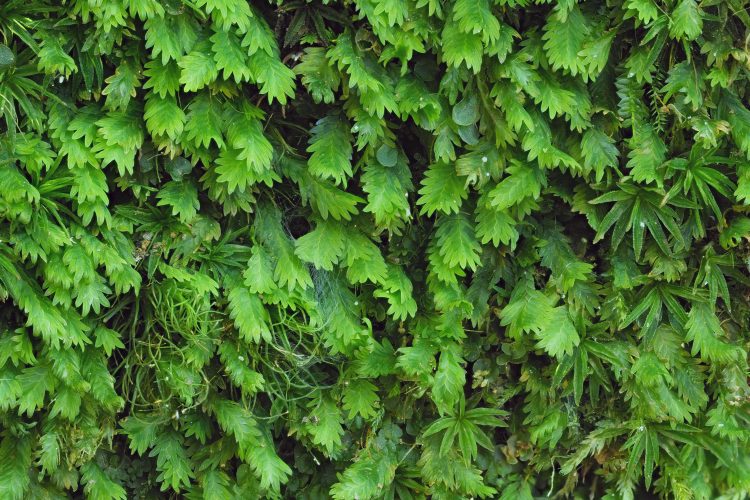
F. elegans on sandstone at Deep Woods, a private nature preserve in Hocking County
Fissidens bushii, inasmuch as it grows on the ground in somewhat disturbed calcareous woodlands, is a bit of a fooler since that is the usual haunt of the much more common F. taxifolius. Look for leaves with a small apiculus (not the claw-like tip of taxifolius), and cells of the vaginant laminae that are are pluripapillose, albeit indistinctly so (in contrast to unipapillose in taxifolius). Fissidens bushii is known from 11 of our counties, primarily in the south- central portion of the state.
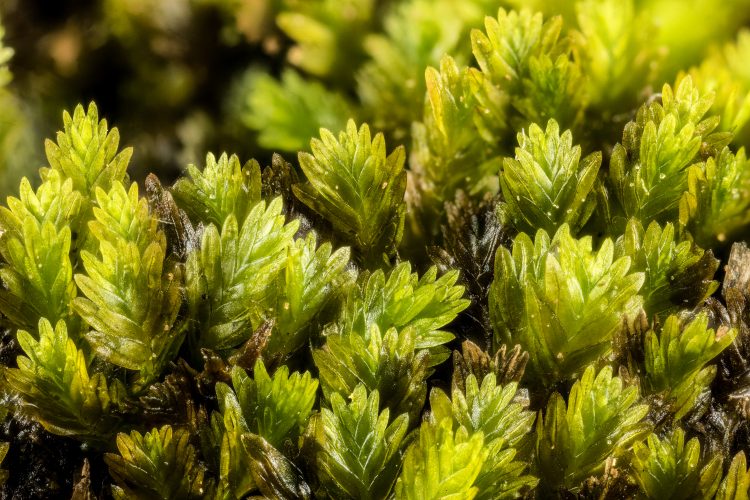
F. bushii at the edge of a wooded bluff at Mt. Gilead State Park in Morrow County
If by now you’re getting a little discouraged, thinking that a compound microscope is necessary to identify every Fissidens, you’re going to like the aptly named Fissidens obtusifolius. It’s a small plant with broad rounded leaf tips, making it absolutely distinctive (though Crum and Anderson say it looks like a small leafy liverwort). An eastern North American endemic, look for F. obtusifolius on wet limestone (sometimes sandstone) and thin soil in limestone areas. It often grows on rocks in streams. We have records from 18 widely scattered counties.
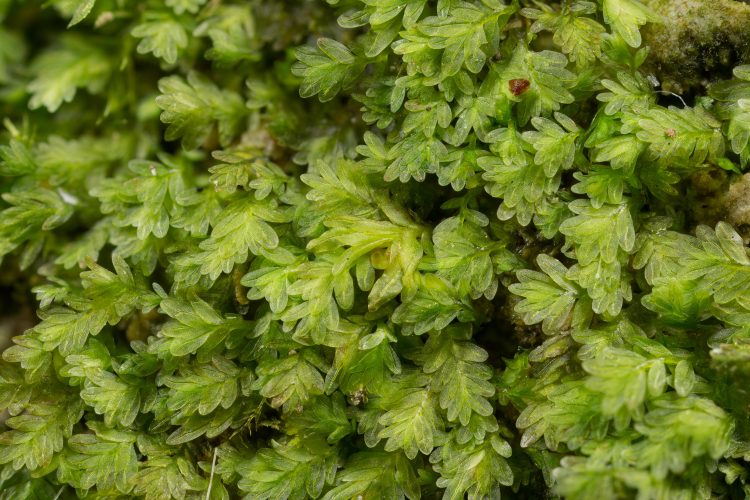
F. obtusifolius on lime stone at Greenvile Falls State Science River, Miami County
Fissidens hyalinus is a great rarity both in Ohio and across its limited eastern North American and eastern Asian ranges (sorry, no photo), with Ohio specimen records only from the two neighboring south-central counties of Hocking and Vinton, northeast Ohio’s Lake County, and the extreme southwestern Hamilton County where, incidentally, the species was first discovered by T.G. Lea in 1839. It’s a minute aquatic with ecostate leaves and especially large cells.
Fissidens exilis — not only rare (13 Ohio county records), it’s easy to miss! A tiny ephemeral growing as scattered but often abundant plants from a persistent protonema, it was first reported in North America by William Steere in a 1950 article in The Bryologist from collections made a few years previously by Maurice Walters (described by Steere as a “well known amateur collector”) on bare clay soil near the mouth of a ravine at the North Chagrin Reservation of the Cleveland Metropolitan Park System. Steere closes his article with a suggestion, saying “The reexamination of herbarium material under various names, especially F. minutulus, F. viridulus, and F. bryoides, may result in the discovery of further specimens of F. exilis.” (Note: F. viridulus and F. bryoides are now regarded as being conspecific.) That being said, a perusal of records on the Consortium of North American Bryophytes portal failed to find any likely instances of earlier specimens found pursuant to Steere’s suggestion. A key character differentiating this moss from the various lookalikes lies in two aspects of the vaginant laminae: their upper edges are free (not fused), so they loosely surround the leaf above instead of clasping it tightly; and they are bordered by one or more rows of cells that are merely irregularly elongate, as opposed to being long and narrow as in, say, Fissidens bryoides.
Pointing out that the species is now known from over a dozen eastern states, Bruce Allen (in Mosses of Maine) posits that it probably represents an inadvertent introduction from Europe!
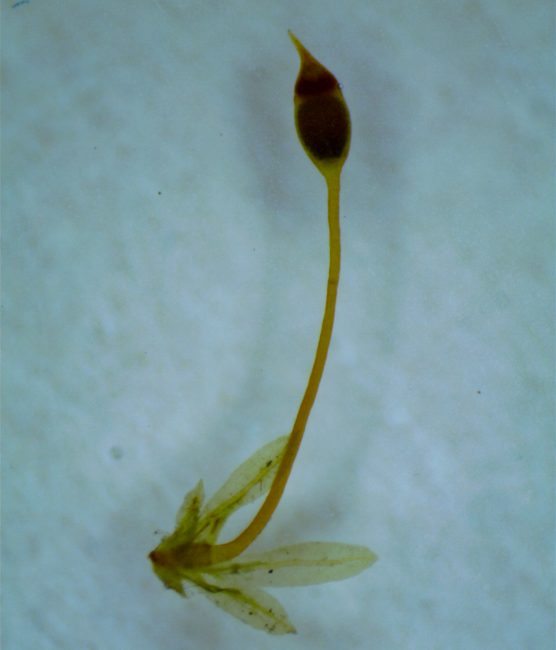
F. exilis, hydrated 15-year old herbarium specimen collected from bear soil alongside an outhouse in rural Hocking county
Fissidens bryoides and F. minutulus are two of our more common pocket mosses, recorded from 47 and 19 counties respectively). They are very similar species (F. minutulus has been considered a variety of a more broadly circumscribed F. bryoides) that occur, often rather abundantly, on wet rocks in or alongside woodland streams.
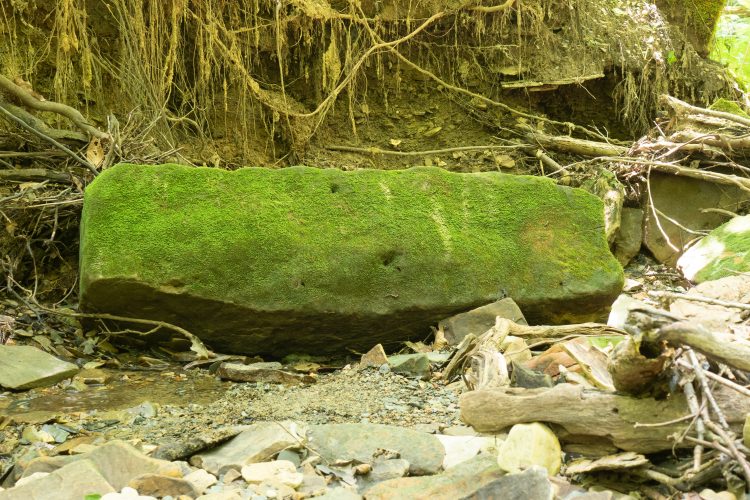
Boulder in stream at Slate Run Metro Park, Pickaway County, covered with Fissidens minutulus.
Because they’re tiny, they’re easily missed, appearing as an indistinct green coating until a close view reveals their distinctive featherlike form. While the small size is generally a reliable way to differentiate these mosses from our other pocket mosses, the definitive trait is a microscopic one, wherein all or some of each leaf margin is bordered by clear linear cells.
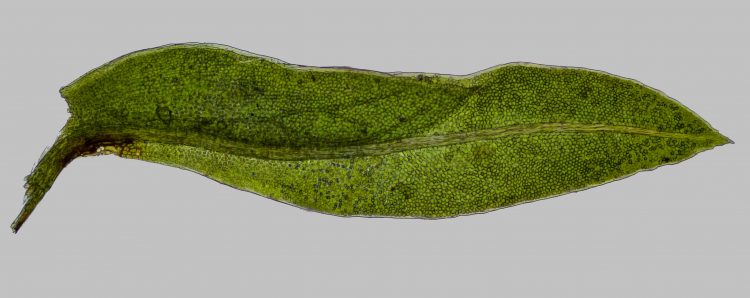
Fissidens bryoides is most often found on acid rocks (granite or sandstone), whereas F. minutulus has more of an affinity for limestone. Physical differences between the two are microscopic and subtle, with F. bryoides having slightly larger cells and a less prominent leaf border. The sexuality of the plants varies but includes forms with both male and female gametangia in the same clusters, so sporophytes are commonly observed, arising from between the uppermost leaves of the wee little plants.
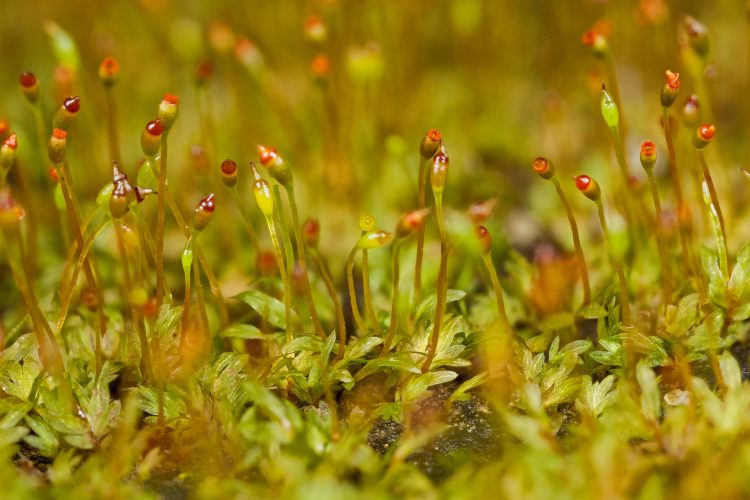
F. bryoides on a wet rock in a stream in Hocking County.
If you explore iNaturalist or NatureServe Explorer—two excellent online repositories of natural history occurrence data and associated information that helpfully include common names for organisms that traditionally haven’t had very good ones— they return the spot-on name “tree pocket moss” for Fissidens subbasilaris. Indeed, a Fissidens growing abundantly on bark is likely to be this species (but don’t get skunked by Anomodon minor, another high- bark moss having a flattened appearance, even though it is not truly 2-ranked, just complanate). It’s known from 11 counties widely spread throughout the state.
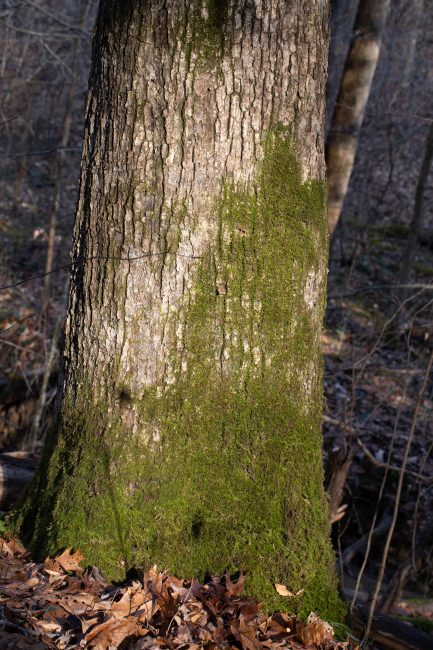
F. subbasilaris is “tree pocket moss,” here seen on an oak tree at Clear Creek metro Park in Hocking County.
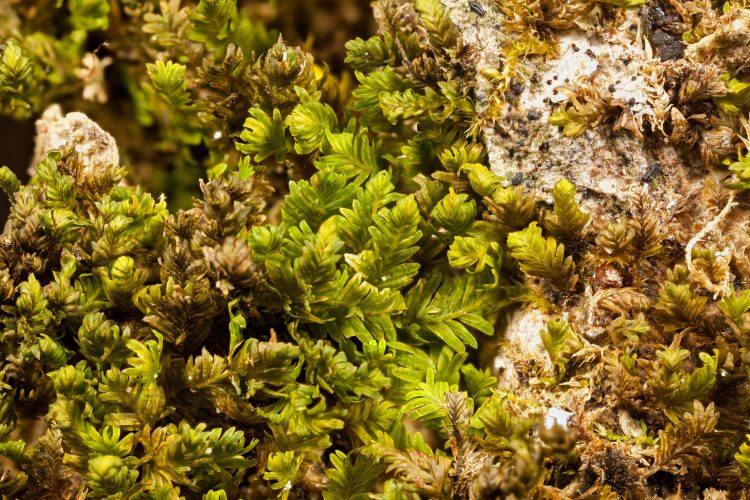
F. subbasilaris at Glen Helen Nature Preserve in Greene County.
Tree pocket moss is small but not tiny, dark- green, with obtuse leaves that have a singular distinctive trait: the costa (mid- nerve) is covered by short green cells. Although perceptible even with a mere hand lens, it’s most obvious under the scope.
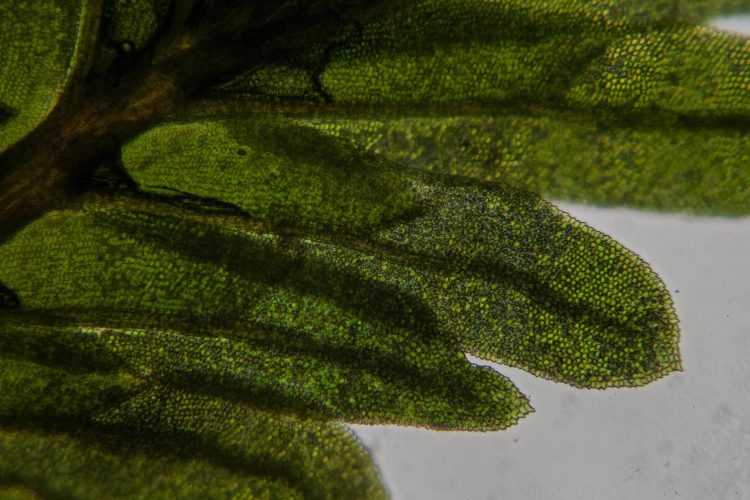
The costa of F. subbasilaris is covered by short green cells, rendering it opaque.
Fissidens osmundioides is a medium-sized moss found in wet shady places, especially sandstone recesses. Most of the 16 Ohio county records are from the Allegheny Plateau.

Fraternizing flat friends pose for a picture on a shaded sandstone cliff in Hocking County. These are Fissidens osmundiodes and the globally rare “sword moss,” Bryoxiphium norvegicum (along with a photobombing stem of Atrichum angustatum).
Compared with two coarsely serrate lookalikes—Fissidens dubius and F. adianthoides)—the leaves of F. osmundioides are relatively smooth- margined. Another trait that differentiates this species from those two plus F. taxifolius is that the sporophytes, instead of arising from the bases of the stems, are attached terminally. Keys that rely on diagnostic features that pertain to sporophytes are often annoying owing to the absence of sporophytes on the specimen at hand. When working with this moss though, look carefully even at seemingly sterile specimens, as they could at least have archegonia (female gametangia from which sporophytes might eventually arise) located in a telling position.
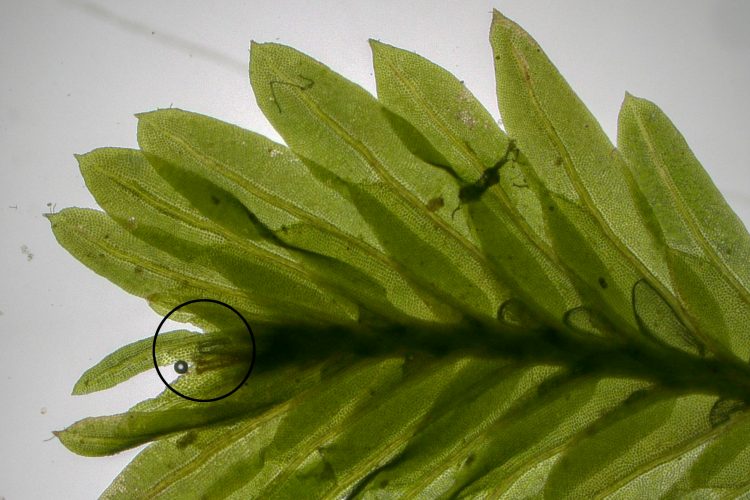
Terminal, not lateral, archegonia (circled) of Fissidens osmundiodes
Fissidens dubius (F. cristatus in older manuals, including Crum and Anderson) and F. adianthoides are both coarsely serrate-leaved pocket mosses with lateral sporophytes and a border of pale cells.
In Fissidens dubius the border is very distinct, even discernable in the field under close examination, whereas in F. adianthoides it’s barely noticeable. (There are also cell size differences, with those of F. adianthoides being about half again as large as those of F. dubius, a size difference paralleled by the plants themselves as F. adianthoides is our largest terrestrial pocket moss.
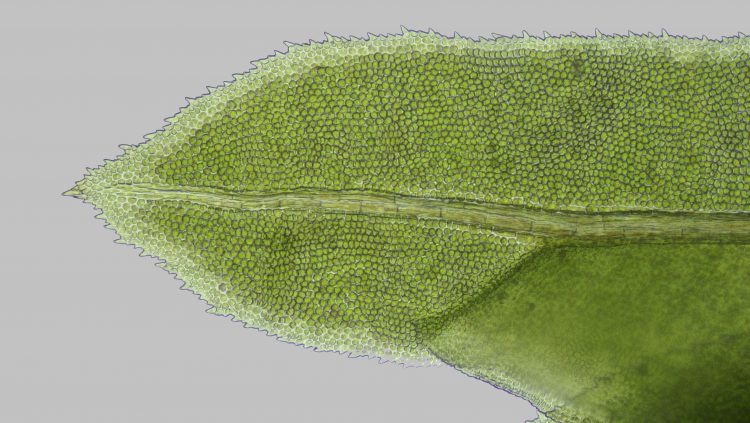
F. dubius leaves have a distinct pale border.
Fissidens dubius, known from 38 Ohio counties, has a wide ecological amplitude substrate-wise, occurring on cliffs, boulders, tree bases, rotten wood and soil.
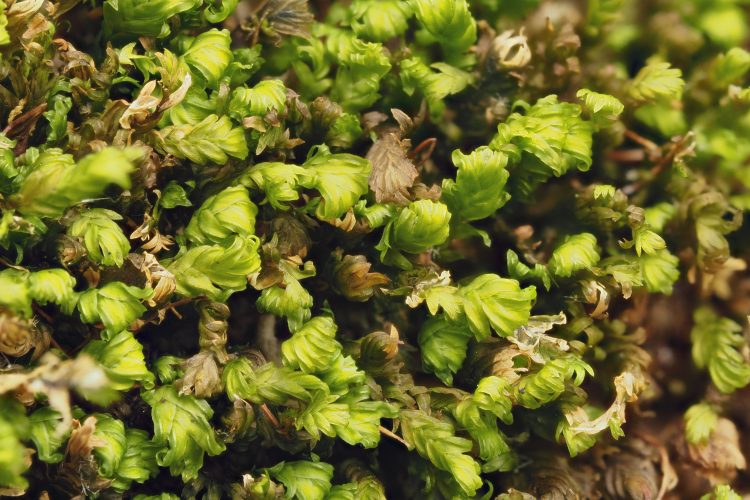
Fissidens dubius during a midsummer drought in a raised portion of a calcareous prairie at Possum Creek Metro Park in Montgomery County.
Crum and Anderson report for Fissidens adianthoides a similar substrate affinity as F. dubius, but seemingly with a greater fidelity towards the wetter end of the spectrum. At Possum Creek Metro Park, where both species occur, F. adianthoides is clearly restricted to the lower, more perennially damp portions of the site. We have 31 county records for this big beautiful moss.

F. adianthoides at Possum Creek Metro Park (juniper branch added for scale).
During a recent bio-blitz at Delaware County Preservation Parks Deer Haven Park, sharp-eyed OMLA member Megan Osika spotted “water pocket moss,” Fissidens fontanus, on some rocks in the stream there. Soon afterwards I posted the record along with this picture on iNaturalist, to which a member of the community disagreed, adding this comment: “this is definitely fontialis. no where near fissidens.. this moss doesnt even have the vaginate laminal that fissidens has.”
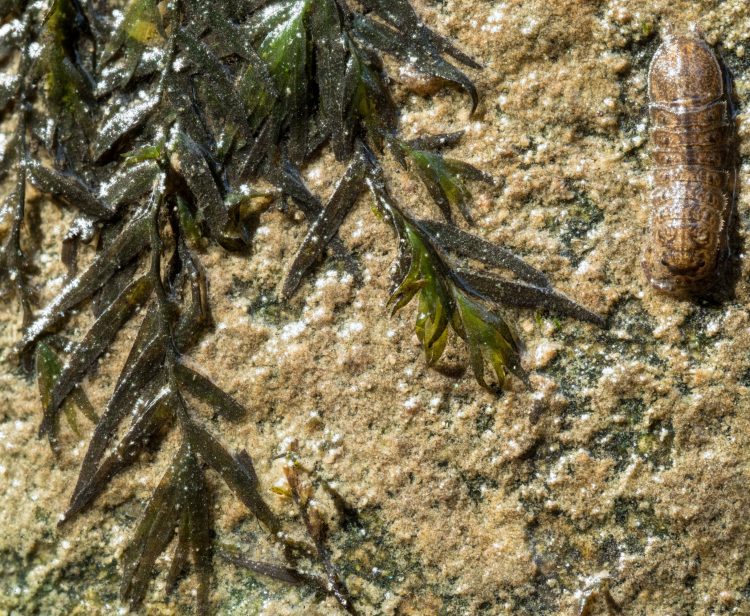
F. fontanus on a rock in a Delaware County stream. It’s known from 17 more counties.
Then came the following tactful intervention by another community member: “Details on aquatic Fissidens are difficult to see in situ because of the soil and algae that accumulates on them. Vaginate lamellae are not obvious on this specimen, yes but are suggested in the leaves on the left. Leaves are also clearly costate to the apex.” While resisting the temptation to say, “Hold my beer!” I then added this photo of a stem section taken through the microscope.

F. fontanus, microscope view.
Soon thereafter our initially skeptical commenter merrily exclaimed “Oh wow. Thank you for that. I can see it now. It is very cool. See you can study species for 25 years and you still learn stuff.”
Amen to that!
-Bob Klips
[from 2019 issue of OBELISK v. 16]
